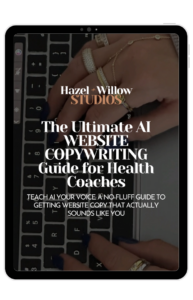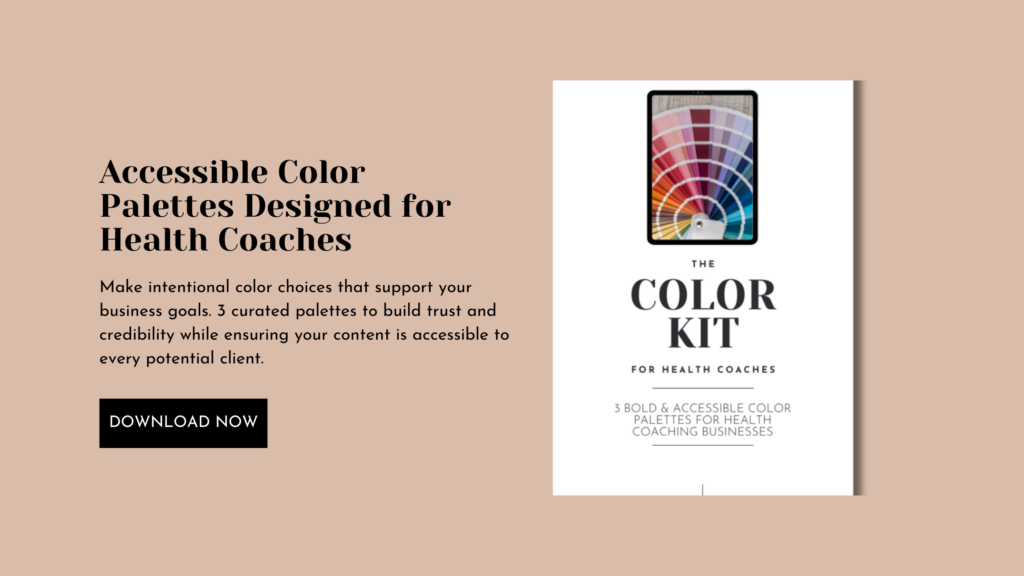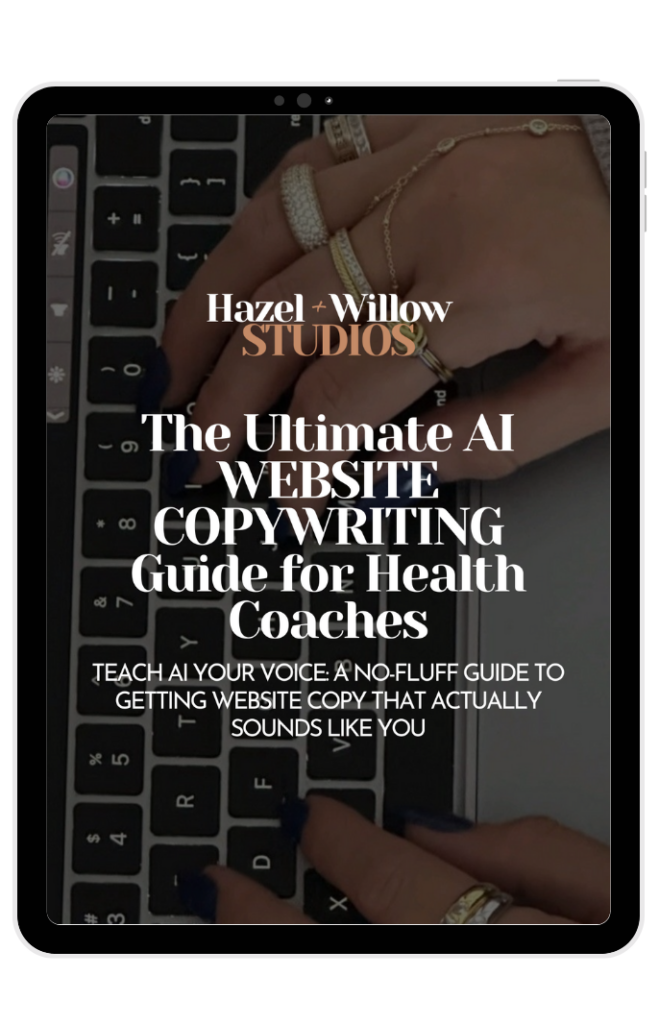Maybe you’ve already dabbled with using AI to write emails or create social posts. Or, perhaps you’re still on the fence, wondering if it’s just going to make your content sound like everyone else’s.
Here’s the truth: AI can be incredibly powerful for health coaches when used correctly, but it can also create some serious pitfalls when mishandled.
As both a certified health coach and a website designer who helps wellness professionals stand out online, I’ve seen firsthand how the right approach to AI can save time while the wrong approach can dilute your unique voice and expertise.
In this post, you’ll discover:
- The most common AI mistakes health coaches make (and how to avoid them)
- Practical strategies to maintain your authentic voice while leveraging AI
- How to craft AI prompts that actually capture your unique approach
- Ways to blend efficiency with authenticity in your wellness business
Related Post: How to Build a Health Coaching Business Without Social Media
Table of Contents
Why Health Coaches Are Turning to AI (And Why It Gets Complicated)
Before diving into the mistakes, let’s acknowledge why AI can be a valuable tool for health coaches. Creating consistent content across your website, social platforms, email newsletters, and client resources is exhausting. You became a health coach to transform lives, not spend hours crafting the perfect Instagram caption or welcome email.
AI promises to handle the heavy lifting of content creation so you can focus on what matters most—your clients.
But here’s where it gets tricky: your voice, expertise, and unique approach to wellness are your greatest assets as a health coach. Generic content that sounds like it could come from any wellness professional won’t build the connection you need with potential clients.
Let’s explore the seven critical mistakes health coaches make when using AI—and how you can sidestep these pitfalls to leverage this technology while preserving what makes your coaching practice special.
Mistake #1: Using Generic Prompts That Result in Generic Content
Perhaps the most common mistake health coaches make is using vague, generic prompts and expecting specific results. Prompts like “write a blog post about good nutrition” or “create content for my health coaching website” provide too little direction and context for the AI to generate truly useful content.
AI has no inherent understanding of your specific approach to health coaching, your voice, or your audience unless you give it that information. The more specific your prompts, the better your results will be.
How to Fix It: Create Context-Rich Prompts
Instead of asking for “a newsletter about stress management,” try something like:
“Draft a newsletter about the connection between stress and blood sugar regulation for my audience of busy professionals with pre-diabetes. Include my perspective that short, frequent stress management practices are more effective than occasional longer ones for blood sugar stability.”
Notice how this prompt includes:
- Specific topic (stress and blood sugar connection)
- Clear audience (busy professionals with pre-diabetes)
- Your unique approach (short, frequent practices vs. longer sessions)
This level of detail gives AI the ability to create content that’s closer to what you would write yourself, requiring less editing to align with your expertise and voice.
Related post: AI for Health Coaches: 10 Ways to Use AI to Scale Your Business
Mistake #2: Losing Your Authentic Voice in AI-Generated Content
Many health coaches worry about losing their authentic voice when using AI. This concern is valid—generic AI output can sound robotic, impersonal, or indistinguishable from countless other wellness websites.
Your voice isn’t just your writing style; it’s the unique way you explain health concepts, the metaphors you use, and how you structure your thoughts. It’s what makes your clients feel like they’re having a conversation with you rather than reading generic health advice.
How to Fix It: Create Brand Voice Guidelines
Before you can maintain your voice with AI, you need to clearly define what that voice is. Many health coaches have a distinct way of communicating when speaking with clients but struggle to translate that to written content.
Consider documenting:
- Three to five adjectives that describe your communication style (examples: warm, direct, encouraging, pragmatic, nurturing)
- Words and phrases you often use with clients
- Topics or approaches you emphasize in your practice
- Metaphors or analogies you use to explain health concepts
- Your typical communication structure (for example, do you start with empathy, then move to education, then action steps?)
Once documented, these guidelines become invaluable for both crafting effective AI prompts and editing AI-generated content to align with your voice.
Want a step-by-step framework for maintaining your authentic voice while using AI? My Ultimate AI Website Copywriting Guide was created specifically for health coaches who want to leverage AI without sounding like everyone else.

This comprehensive guide walks you through exactly how to craft AI prompts that capture your unique approach to wellness, transform generic content into your distinct voice, and create website copy that resonates with your ideal clients. It’s perfect if you’re tired of staring at blank pages but worried about ending up with generic wellness content that could belong to any health coach.
Mistake #3: Publishing AI Content Without Thorough Editing
Another critical mistake is using AI-generated content without thoroughly reviewing and editing it first. No matter how sophisticated your prompt, AI output should be considered a first draft rather than finished content.
AI may occasionally include inaccurate health information, make overly broad claims, or use language that doesn’t align with your approach. Every piece of content should pass through your expert filter before reaching your audience.
How to Fix It: Establish an Editing Process
The most important thing to understand about using AI for content creation is that the initial output is just a starting point. The editing phase is where you transform generic content into something that genuinely represents you and your practice.
Effective editing goes beyond basic proofreading. It involves:
- Adding personal stories and examples that only you could share
- Incorporating your specific methodology and approach
- Infusing your unique perspective on health and healing
- Including phrases and metaphors that are distinctly yours
- Restructuring content to match how you naturally communicate
Think of AI as providing the structure and basic information, while you provide the soul and personality. With practice, you’ll develop an efficient editing process that quickly transforms AI drafts into authentic content that genuinely sounds like you.
Mistake #4: Relying on AI for Health Advice and Expertise
While AI can help organize and articulate health information, it should never be the source of the health advice you provide to clients. The information AI generates comes from its training data, which may include outdated or conflicting health perspectives rather than your specific approach.
This is particularly important for health coaches who work with clients experiencing complex conditions. AI-generated advice won’t account for the nuanced interplay of factors you observe in your clients unless you explicitly provide that context.
How to Fix It: Use AI as a Structure Tool, Not an Expert
Use AI to help structure and express your expertise, not as a replacement for it. Your education, experience, and professional judgment should always be the foundation of any health guidance you offer.
For example, instead of asking AI to “write about leaky gut treatments,” provide the specific framework, methods, and approaches you use with your clients, and ask the AI to help organize this information in a clear, readable format.
This might look like: “I help my clients address gut permeability through a three-phase approach that begins with reducing inflammatory foods, then focuses on gut repair with specific nutrients, and finally introduces probiotics and prebiotics. Can you help me structure this information into a clear client handout that follows this sequence?”

Mistake #5: Over-Automating Client Communications
The relationship between a health coach and client is built on trust and personal connection. While AI can help create templates for client communications, resist the temptation to automate too much of this relationship.
Initial drafts of check-in emails or session follow-ups might be created with AI assistance, but always personalize them with specific references to your client’s situation, progress, and challenges. Notice what makes each client unique and reflect that in your communications.
How to Fix It: Balance Automation with Personalization
The most successful health coaches use AI to handle the structural elements of client communications while personally crafting the aspects that demonstrate their attention and care for each individual client.
Create a system where you use AI to draft the bones of regular communications, but always add personalized elements that reflect your client’s unique journey before sending. This might include:
- Specific references to what they shared in your last session
- Acknowledgment of a personal challenge or win they recently experienced
- Customized suggestions based on their individual progress
- Questions that follow up on their specific goals
This balanced approach saves time while preserving the personal connection that makes your coaching valuable.
Mistake #6: Neglecting SEO in AI-Generated Content
While creating authentic, valuable content is primary, ignoring search engine optimization can limit the reach of your content. Many health coaches create excellent content that never reaches potential clients because it doesn’t align with what people are actually searching for.
The most beautiful website in the world won’t help your business if no one finds it. And that means understanding at least the basics of SEO.
How to Fix It: Integrate SEO Best Practices Into Your AI Process
Use AI to help research relevant keywords and topics in your niche. Tools like ChatGPT can suggest related search terms or help you understand the questions potential clients might be asking about your area of expertise.
Then, incorporate these insights into your content strategy, ensuring you’re addressing the real questions and concerns of your ideal clients while maintaining your authentic voice and approach.
A well-structured approach might look like:
- Research keywords relevant to your health coaching niche
- Use these keywords to guide your content topics
- Include these terms naturally in your AI prompts
- Ensure keywords appear in your headings, introduction, and throughout your content
- Format content with proper H1, H2, and H3 tags for better search visibility
Need help with your health coaching website? Learn about the 7 Essential Elements Every Successful Health Coaching Website Needs
Mistake #7: Focusing on Quantity Over Quality
The efficiency AI offers can sometimes tempt health coaches to prioritize content quantity over quality. While consistency matters in content marketing, publishing generic or shallow content can actually damage your professional reputation.
Rather than using AI to create more mediocre content, use it to create better content more efficiently. Focus on providing genuine value with each piece you publish that reflects your expertise and offers actionable insights for your audience.
How to Fix It: Create a Value-First Content Strategy
One thoughtful, well-crafted article that addresses a specific challenge your ideal clients face will do more for your business than five generic pieces on wellness topics.
When planning your content:
- Identify the specific challenges and questions your ideal clients have
- Use AI to help organize and articulate your unique insights
- Always prioritize providing genuine value over hitting publishing quotas
- Include specific action steps or takeaways in every piece of content
Advanced AI Prompt Engineering for Health Coaches
As you become more comfortable using AI in your health coaching business, you’ll discover that the quality of your prompts directly influences the quality of the output. Let’s explore how to craft more sophisticated prompts that produce truly useful results.
The Elements of an Effective AI Prompt
Think of prompt engineering as a conversation with a very intelligent assistant who doesn’t know you or your business unless you tell them. The more context and guidance you provide, the better the results will be. An effective prompt typically includes:
- Your role and expertise: “I’m a certified health coach specializing in autoimmune conditions with a focus on anti-inflammatory nutrition and stress management.”
- Your audience: “My clients are primarily women in their 30s-50s who have been struggling with fatigue, joint pain, and digestive issues for years despite seeing multiple practitioners.”
- Your brand voice: “My communication style is warm but straightforward, blending evidence-based information with compassionate guidance. I tend to use accessible language rather than medical jargon.”
- The specific task: “I need to create a welcome email for new subscribers that introduces my approach to autoimmune health.”
- The desired format and length: “The email should be approximately 300-400 words, written in a conversational tone with a clear next step for the reader.”
- Additional context or examples: “Here’s an example of my writing style from a recent newsletter…” (including examples of your existing content helps AI match your voice)
When all these elements come together, the AI has a much clearer picture of what you need and can generate content that requires less editing on your part.
If you’re ready to master the art of AI prompting specifically for your health coaching website, check out my Ultimate AI Website Copywriting Guide. Unlike generic AI tutorials, this resource is tailored specifically for wellness professionals who need to communicate complex health concepts authentically. You’ll discover expert techniques for communicating your methodology and client transformation stories, see real examples of before-and-after AI copy transformations, and get the exact prompts to create effective copy for your website. Stop settling for generic wellness industry language and start creating copy that captures your unique coaching philosophy.
The Voice Calibration Process
As you continue working with AI tools, you’ll develop a process I call “voice calibration”—progressively training the AI to better match your natural communication style. This happens through:
- Providing examples: Including snippets of your existing content in prompts
- Specific feedback: Telling the AI exactly what aspects of its output don’t match your voice
- Iterative refinement: Using each interaction to get closer to your authentic voice
For example, if the AI generates content that’s too formal for your conversational style, your next prompt might include: “The previous response was too formal and academic. I typically speak to my clients like a knowledgeable friend, using conversational language and occasionally humor. Please rewrite with a warmer, more approachable tone.”
Over time, your prompts become more effective at eliciting content that requires less editing to match your voice. This creates a virtuous cycle where AI becomes increasingly valuable as a writing partner.
When to Write From Scratch
While AI can be incredibly helpful for many content needs, some pieces are better written entirely by you. Consider writing completely from scratch when:
- Sharing deeply personal stories about your health journey or why you became a health coach
- Communicating your core philosophy or mission statement
- Creating content about the most unique aspects of your methodology
These pieces often form the foundation of your brand and deserve your full creative attention. AI can still help organize your thoughts or suggest structures, but the actual writing should come directly from you.
Your Next Steps to Better AI Use in Your Health Coaching Business
Now that you understand the common mistakes health coaches make with AI and how to avoid them, here are your next action steps:
- Document your brand voice guidelines using the framework shared above
- Create a template for AI prompts that includes all the essential elements
- Develop an editing process that efficiently transforms AI drafts into your authentic voice
- Practice voice calibration with each AI interaction
- Identify content categories where AI can help most and areas where you should write from scratch
Finding Balance Between AI Efficiency and Authentic Connection
AI is a powerful tool for health coaches, but it’s just that—a tool. The real magic happens when you use it strategically to handle the structural aspects of content creation while preserving the personal touch, unique insights, and authentic voice that make your coaching practice special.
By avoiding these seven mistakes, you can leverage AI to grow your business more efficiently without sacrificing the authentic connection that’s at the heart of effective health coaching.
Remember, your clients choose to work with you because of your unique approach, experiences, and personality. Use AI to amplify these qualities rather than replace them, and you’ll find the perfect balance between technological efficiency and authentic human connection.

Ready for a complete system to master AI copy for your health coaching website? My Ultimate AI Website Copywriting Guide goes beyond these tips to provide a comprehensive framework for creating all your website content with AI while maintaining your authentic voice. This in-depth resource shows you the exact prompts for transforming generic AI copy into content that reflects your unique coaching style, communicate your methodology effectively, and create converting copy that resonates with your ideal wellness clients. It’s the perfect next step if you’re serious about leveraging AI while staying true to your health coaching philosophy and standing out in the increasingly crowded wellness space.
